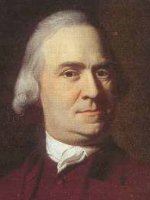“Wishing you Every Blessing in Time and Eternity”
Small portions of this letter have been transcribed and published, sometimes with an erroneous date and other errors. Here’s my best rendering at the whole text (with added paragraph breaks for easier reading).
Cambridge Feb 12, 1776I hadn’t included Elizabeth Adams on the list of people who visited the Washingtons in Cambridge before, but this letter shows she did.
My Dear
I Receivd your affectinate Letter by Fesenton [express rider Josiah Fessenden], and thank you for your kind Concern for My health and Safty. I beg you Would not give your self any pain on our being so Near the Camp. the place I am in is so situated that if the Regulars should Ever take prospect hill (which God forbid) I should be able to Make an Escape, as I am Within a few stones Cast of a Back Road Which Leads to the Most Retired part of Newtown.
if a Large Reinforcement should Come in to Boston I propose to send the Best of my things into the Country, and have My Self Nothing but a bed and a few Necessarys, and be in Readiness to Move at an Minutes Warning—
Mr. [John] Adams made me a visit after I Wrote to you, so I Must aquit him of treating me with Neglect. I Should have sent a Letter by Him, but I was unexpectedly sent for three days to dine at Cambridge, With Samey [?] and was treated by General Washington and his amiable Lady With great Friendship.
I’m not sure about the name “Samey” or, if that’s the right transcription, who it referred to. Samuel Adams’s son by his first wife was also named Samuel, but at this point he was a grown man and a doctor serving in the army, and he and Elizabeth were usually more formal with each other.
I was in hopes I should had the opportunity of Returning the Compt. by inviting them to dine with you at our house, but by what Fesenton tells Me I fear I shall not see you so soon as I Flatterd My self. I beg (My dear) you would try to Come if the visit is Ever so Short——Job was a servant boy the Adams family had hired a couple of years before. I’ve written about wanting to identify him. This paragraph adds a clue: Job was from Boston, not a rural town, and his father was still alive in 1776.
I saw the Doct. [I think this is Dr. Samuel Adams, Jr.] this day he is Well and says he Wrote to you last Week. Jobs Father and his family is come out of Boston, but I have not seen him so that I Cannot tell what he has done with the things we left in his Care.
a great Number of the poor Come out Every Week, and are taken good Care of by the Committe Chose for that Purpose——Elizabeth Adams’s mother, Susanna Wells, was evidently accompanied by her daughter Hannah (c. 1755–1803), then unmarried.
I Supose you have heard that a great Number of tories are gone to England, old gray among them. young Mr [William] Peperell has lost his Wife. [Thomas] Flukers youngest Daughter [Sally] is an actress on the stage in Boston, and her Father and Mother gone home. Mr. [James] Otis daughter [Elizabeth] is Married to an Regular officer [Leonard Brown].
they have pulled down a great many houses for fire Wood among nothers in our Neighbourhood are old Mr. grays, Blairs Coles [?] and Walcuts and an Number in long Lain. you see that I Write you all the News however trifling.
that house that Mother Lived in of Mrs. Carnes is Burnt, and and [sic] all her goods taken away by the soldrs. I saw her last Week, she is Well, and Boards at one Mr Sanders at Waltham where she is treated very kind. She has her Board and Hannahs paid out of the donations. She sends you her best Love and Blessing.
In the following paragraph, “Polly” was someone Samuel Adams sent greetings to as “Sister Polly,” so I’m guessing she was Mary Checkley (b. 1721), sister of his late first wife. “Surry” was an enslaved woman given to the family, whom at some point Adams freed.
Polly desires her particular Regards to you and thanks you for the kind manner you Mention her in your Letters. We are all in good health. Surry and Job send their duty—after Wishing you Every Blessing in Time and Eternity, I subscribe My self yoursBack in June 1775, Samuel had closed a letter to Elizabeth, “when I am in Want of Money I will write to you.” The family’s only source of income was the Massachusetts government, which of course was in some flux.
Elizah. Adams
PS. I beg you to Excuse the very poor Writing as My paper is Bad and my pen made with Scissors. I should be glad (My dear) if you should not come down soon, you would Write me Word Who to apply for some Monney for I am low in Cash and Every thing is very dear
—adieu




